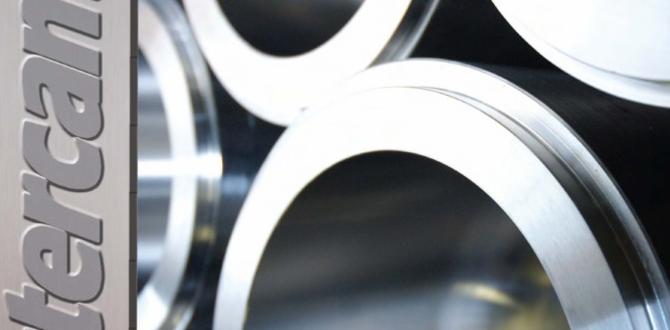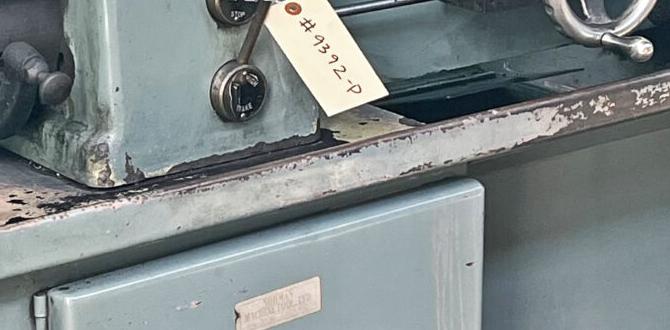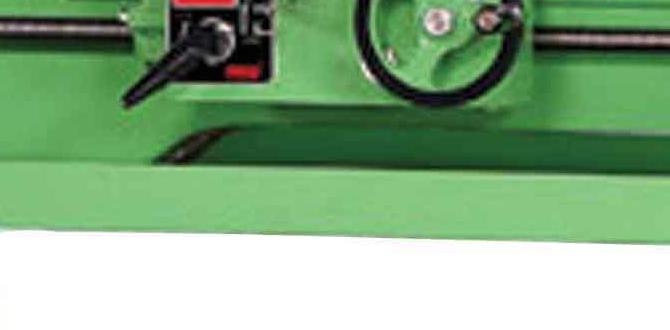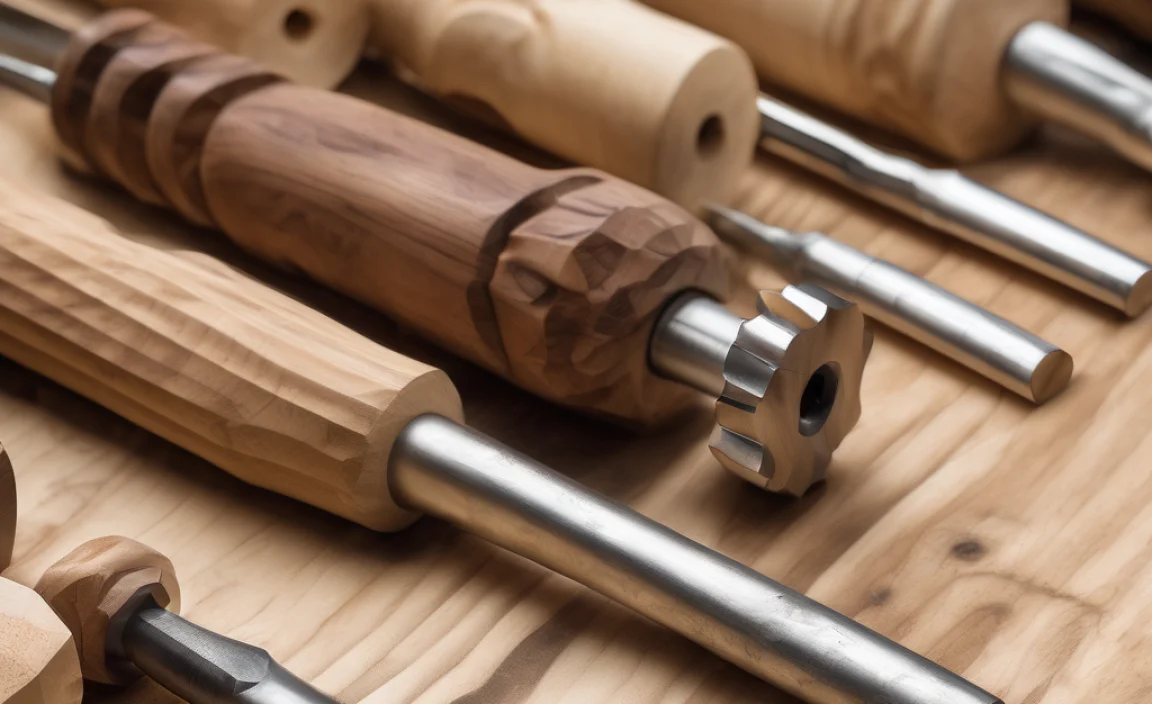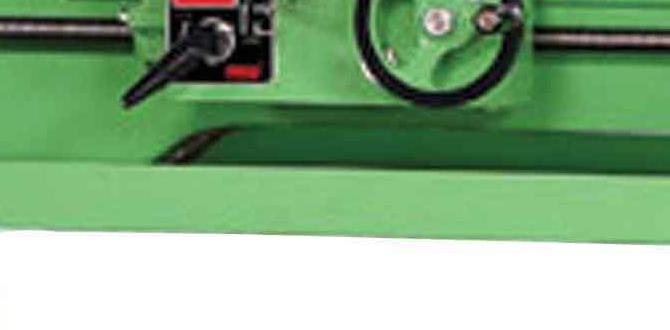For easy and efficient copper machining, a 40-degree TiALN ball nose end mill provides excellent ramping capabilities, reducing chatter and improving surface finish. This guide shows beginners how to leverage this tool for smooth, precise copper cuts.
Working with copper can be a bit tricky. It’s softer than steel but can still gum up your tools if you’re not careful. When it comes to milling, especially creating smooth, curved surfaces or cutting intricate shapes, getting the right tool and technique is key. Ramping, which is feeding the end mill down at an angle into the material, is a fantastic way to tackle copper. It helps clear chips better and reduces the stress on both your tool and your machine. Today, we’re going to break down how to use a TiALN coated, 40-degree ball nose end mill for ramping in copper, making your machining tasks smoother and more successful.
Why Choose a 40-Degree TiALN Ball Nose End Mill for Copper Ramping?
Copper is a material that machinist a lot of us love to work with. It’s beautiful, conducts heat and electricity well, and is relatively easy to machine compared to harder metals. However, it has a tendency to be gummy, meaning it can stick to the cutting edges of your tool, leading to a poor surface finish, tool wear, and even tool breakage.
When you’re doing operations like pocketing, contouring, or 3D profiling, you often need to feed your end mill into the material at an angle. This is called ramping. Traditional plunging, where the tool enters the material straight down, can be rough on the tool and the workpiece, especially with softer, gummier materials like copper. Ramping allows the tool to engage with the material more gradually, leading to smoother cuts and better chip evacuation.
This is where the 40-degree TiALN ball nose end mill shines. Let’s break down why:
Ball Nose Design: The rounded tip is perfect for creating smooth, contoured surfaces and fillets. Unlike a flat-bottomed end mill, its full radius allows it to finish a radiused pocket in a single pass without needing to pick out small corners.
40-Degree Helix Angle: This is a sweet spot for many materials, including copper. A steeper helix angle (like 45 or 50 degrees) might cut aggressively but can also increase chatter and vibration. A shallower angle might be too weak for aggressive ramping. The 40-degree angle strikes a balance, offering good flute space for chip evacuation while still providing a strong cutting edge that can handle the forces involved in ramping.
TiALN Coating: TiALN (Titanium Aluminum Nitride) is a popular coating for machining a wide range of materials, especially at higher speeds and temperatures. For copper, it offers several benefits:
Reduces Friction: The coating creates a smoother surface between the tool and the workpiece, which is crucial for preventing that gummy copper from sticking.
Increases Hardness: It adds an extra layer of hardness to the cutting tool, improving wear resistance.
High-Temperature Performance: While copper isn’t usually machined at extreme temperatures that would benefit greatly from TiALN’s heat resistance, it still contributes to overall tool longevity by helping to manage thermal load during cutting.
Understanding the Basics of Ramping
Before we dive into specific settings, let’s get a clear picture of what ramping is. Imagine you’re trying to cut a spiral staircase into a material. You don’t just drill straight down; you feed the tool sideways and downwards at the same time to create that slope. That’s essentially what ramping is in CNC machining.
Instead of a direct plunge cut, the end mill enters the material at an angle. This can be done in a linear path (straight line) or a helical path (a spiral). For copper, both can be effective, but helical ramping is often preferred as it’s smoother and distributes the cutting load more evenly.
The goal of ramping is to:
- Reduce cutting forces.
- Improve chip evacuation, preventing the workpiece from packing up with chips.
- Minimize tool chatter and vibration.
- Achieve a better surface finish.
- Extend tool life.
Key Considerations for Using Your 40-Degree Ball Nose End Mill in Copper
Working with copper requires a slightly different approach than machining steel or aluminum. Its ductility and thermal conductivity mean we need to pay attention to a few specific factors.
1. Material Properties of Copper
Copper is an excellent conductor of heat, which might sound good, but it means heat generated during cutting can be quickly transferred into the cutting tool. This can lead to rapid tool wear if not managed properly. It’s also softer and gummier than many other metals, which is why chip clearance and preventing built-up edge (BUE) are so important. Tools coated with TiALN help combat the BUE.
2. Tool Selection Deep Dive
Diameter: The diameter of your ball nose end mill will depend on the features you need to create. For general contouring and pocketing, a 1/4-inch or 1/2-inch diameter is common. Smaller diameters are great for intricate details, while larger ones are good for removing material quickly in larger areas.
Flute Count: For softer materials like copper, 2-flute or 3-flute end mills are generally preferred.
2-Flute: These have more open flute space, which is excellent for chip evacuation. This is particularly beneficial for gummy materials like copper.
3-Flute: These can provide a smoother finish and slightly better rigidity than 2-flute mills, making them a good choice if chip evacuation is well-managed.
Coating: As discussed, TiALN is a great choice. It provides a good balance of toughness and lubricity. For copper specifically, some machinists also use uncoated carbide tools, but the TiALN coating offers significant advantages in reducing friction and wear.
Helix Angle: We’ve focused on the 40-degree helix. This is a versatile angle that allows for good chip control and cutting performance without being overly aggressive, which can cause chatter in copper.
Ball Nose Radius: This should match the fillets or radii you need in your design. A larger radius will be stronger and remove material faster, while a smaller radius is for finer details.
3. Setting Up Your Machine and Material
Proper setup is crucial for successful machining.
Workholding: Ensure your copper workpiece is held securely. Copper is relatively soft, so excessive clamping force can deform it. Use appropriate clamping methods like vises with soft jaws, step clamps, or fixtures. A stable setup prevents vibration, which is essential for good surface finish and tool life.
Machine Rigidity: Ensure your milling machine is stable and free of excessive play in the ways or spindle. This will translate to cleaner cuts and less chatter.
Zero Point: Accurately set your machine’s zero point (X, Y, and Z axes) relative to your workpiece. This ensures your program will machine the part exactly where you intend it to.
4. Coolant/Lubrication: Your Copper’s Best Friend
Copper can get hot quickly and stick to tools. Using a coolant or lubricant is not just recommended; it’s practically essential for good results, especially when ramping.
Types of Lubricants:
Flood Coolant: A continuous flow of coolant is the most effective for dissipating heat and washing away chips.
Mist Coolant (MQL – Minimum Quantity Lubrication): This sprays a fine mist of coolant and air onto the cutting zone. It’s efficient for softer metals like copper and uses less fluid.
Cutting Fluid Stick/Paste: For manual milling or very simple operations, a specialized cutting fluid applied directly can help. For CNC ramping, flood or mist is far more effective.
Benefits:
Temperature Control: Keeps the cutting edge cool, preventing premature wear.
Chip Evacuation: Floats chips away from the cutting zone, preventing re-cutting and BUE.
Lubrication: Reduces friction between the tool and workpiece.
For ramping in copper, a copious amount of coolant delivered as a flood or mist is highly recommended. You can find specialized cutting fluids for copper and copper alloys that help reduce friction and prevent galling. For example, The Copper Development Association offers comprehensive guides to machining copper, including recommendations for lubricants.
Step-by-Step Guide: Ramping with a 40-Degree TiALN Ball Nose End Mill
Let’s get practical. Here’s how you’d typically program and execute a ramping operation for copper. Remember that these are general guidelines; always refer to your CAM software’s recommendations and perform test cuts if unsure.
Step 1: CAM Programming – Setting Up the Ramping Toolpath
Most CAM (Computer-Aided Manufacturing) software will have options for ramping.
Tool Selection: Select your 40-degree TiALN ball nose end mill from your tool library. Ensure its parameters (diameter, number of flutes, coating, etc.) are accurately entered.
Operation Type: Choose a 3D contouring, pocketing, or adaptive clearing strategy that supports ramping.
Ramping Strategy:
Linear Ramping: The tool moves diagonally from the surface down to the cutting depth. Angle values are typically set at degrees.
Helical Ramping: The tool moves in a spiral path, engaging the material gradually. This is often the preferred method for smoother cuts and better chip control in copper. Your CAM software will usually let you define the helix diameter and step-down per revolution.
Ramp Angle/Step:
For Linear Ramping: Set the angle to something suitable for copper. A common starting point is between 3° and 5° for ramping into the material. Steeper angles increase cutting forces.
For Helical Ramping: Define a small step-down per revolution (e.g., 0.010″ to 0.050″ depending on tool diameter and machine capability). The software will calculate the actual engagement angle. The key is that the tool doesn’t plunge straight down.
Stepover (Axial/Radial):
Axial Stepover (for surface finishing): This is the distance the tool moves down between passes when finishing. For ball nose end mills in 3D surfacing, it’s often very small (e.g., 0.002″ – 0.005″) for a good finish.
Radial Stepover (for clearing): This is how much the tool moves sideways between passes when clearing material. This will depend on the cutting flute diameter and desired finish.
Plunge Moves (if not using pure ramping): If your strategy isn’t 100% ramp-based, define your plunge moves carefully. However, for ramping operations that start from an open area, you often don’t need separate plunge moves.
Example Parameters (Beginner Friendly – Adjust based on your specific tool and machine):
Here’s a table showing some example parameters. Always consult your tool manufacturer’s recommendations and perform test cuts.
| Parameter | Recommended Value for Copper | Notes |
|---|---|---|
| Spindle Speed (SFM) | 150 – 250 SFM | Adjust based on coolant and machine rigidity. Higher speeds may work with excellent coolant. |
| Feed Rate (IPM) | 0.003″ – 0.008″ per tooth | Start conservatively and increase if chip formation is good. |
| Ramp Angle (Linear) | 3° – 5° | Gentle entry to reduce cutting forces. |
| Helical Step-Down (per rev) | 0.010″ – 0.030″ | Determines the effective ramping angle. |
| Axial Stepover (Finishing) | 0.002″ – 0.005″ | For smooth surface finish. |
| Radial Stepover (Roughing) | 0.100″ – 0.200″ (or 50% of tool diameter) | Balance of material removal rate and chip load. |
| Depth of Cut (Total) | Varies – engage tool as needed within its flute length. | Don’t exceed flute length. |
Note: SFM stands for Surface Feet per Minute, which is a measure of cutting speed. IPM stands for Inches per Minute, which is the feed rate.
Step 2: Generating G-code and Post-Processing
Once your toolpaths are defined, your CAM software will generate G-code. This is the set of instructions your CNC machine understands. You’ll need to select the correct post-processor for your specific CNC machine to ensure the G-code is formatted correctly.
Step 3: Machine Setup and Tool Loading
Load the Tool: Carefully insert your 40-degree TiALN ball nose end mill into the spindle collet. Ensure it’s seated properly and tightened securely.
Set Z-Axis Origin: Using a tool setter or the machine’s touch-off procedure, accurately set the Z-axis zero point for the tool. For roughing and finishing passes, ensure your Z-depths are correct.
Material Clamp Check: Double-check that your workpiece is firmly secured.
Step 4: Coolant and Lubrication Check
Ensure your coolant system is functioning correctly and that you have sufficient fluid. If using MQL, verify the mist output.
Step 5: Dry Run (Air Cut)
Before cutting into your valuable copper, it’s wise to perform a “dry run” or “air cut.” This means running the program with the spindle off, or with the Z-axis set significantly higher than the workpiece, to watch the toolpath movement. This helps catch any obvious programming errors or collisions.
Step 6: Executing the Cut
Start the Spindle and Coolant: Turn on the spindle to your programmed speed and engage the coolant.
Initiate the G-code: Start the CNC program.
Monitor the Cut: Watch and listen carefully as the machine operates.
Listen for Unusual Noises: Chatter, grinding, or excessive buzzing can indicate problems like incorrect speeds/feeds, tool deflection, or poor chip evacuation.
Watch Chip Formation: Good chips are typically curly and a bright, non-burnt color. If chips are powdery, stringy, or burning, adjust your feed rate or spindle speed.
Observe Surface Finish: Visually inspect the cut as it progresses. Look for a smooth, consistent finish.
Check for Built-Up Edge (BUE): Periodically stop the machine (safely!) and check the cutting edges for material buildup. If you see copper sticking, you may need to slow down your feed rate, increase coolant flow, or adjust spindle speed.
Step 7: Adjustments and Refinements
If you encounter issues during the cut, don’t be afraid to pause the machine and make adjustments.
Too Chattery? Try slightly reducing the spindle speed, increasing the feed rate per tooth, or adjusting the ramping angle. Ensure your workholding is secure.
Gummy Chips/BUE? Slow down your feed rate, increase coolant flow, or slightly increase spindle speed (if not causing chatter).
* Poor Surface Finish? Reduce the axial stepover for finishing. Ensure the tool is sharp and not worn.
Tooling Considerations & Best Practices Table
It’s always good to have a quick reference for best practices.
| Best Practice | Description | Why it Matters for Copper Ramping |
|---|---|---|
| Proper Speeds and Feeds | Use manufacturer recommendations as a starting point. | Copper’s tendency to gum up means you need a balance of speed (to prevent heating) and feed (to avoid chip welding). |
| Generous Coolant/Lubrication | Flood or mist coolant is highly recommended. | Dissipates heat, lubricates the cut, and flushes chips away, all critical for preventing BUE and tool wear. |
| Rigid Setup | Secure workpiece and stable machine. | Minimizes vibration and chatter, leading to better finish and accuracy. Prevents deformation of soft copper. |
| Sharp, High-Quality Tooling | Use a fresh, sharp 40-degree TiALN ball nose end mill. | A dull tool will exacerbate the gummy nature of copper, leading to poor finish and tool breakage. |
| Effective Chip Evacuation | Ensure flute space is clear. Choose appropriate chip load. | Preventing chips from getting recut is crucial. Ramping helps, but good feed rates and coolant also play a role. |
| Gradual Engagement | Use ramping (linear or helical) with shallow angles. | Reduces shock and cutting forces compared to direct plunge. |
|
|

